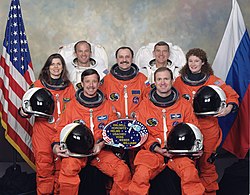STS-101
| Mission emblem | |||
|---|---|---|---|

|
|||
| Mission dates | |||
| Mission: | STS-101 | ||
| COSPAR-ID : | 2000-027A | ||
| Crew: | 7th | ||
| Begin: | May 19, 2000, 10:11:10 UTC | ||
| Starting place: | Kennedy Space Center , LC-39A | ||
| Space station: | ISS | ||
| Coupling: | May 20, 2000, 04:30:45 UTC | ||
| Decoupling: | May 26, 2000, 23:03:00 UTC | ||
| Duration on the ISS: | 5d 18h 32min 15s | ||
| Landing: | May 29, 2000, 06:20:17 UTC | ||
| Landing place: | Kennedy Space Center, Lane 15 | ||
| Flight duration: | 9d 20h 9min 7s | ||
| Earth orbits: | 155 | ||
| Rotation time : | 91.0 min | ||
| Track height: | 320 km | ||
| Covered track: | 6.6 million km | ||
| Team photo | |||
 v. l. No. front: Scott Horowitz, James Halsell; back: Mary Weber, Jeffrey Williams, Juri Ussatschow, James Voss, Susan Helms |
|||
| ◄ Before / After ► | |||
|
|||
STS-101 ( english S pace T ransportation S ystem) is the mission designation for a flight of the US Space Shuttle Atlantis ( OV -104) of NASA . The launch took place on May 19, 2000. It was the 98th space shuttle mission, the 21st flight of the space shuttle Atlantis and the third flight of a shuttle to the International Space Station (ISS).
team
- James Halsell (5th space flight), commander
- Scott Horowitz (3rd space flight), pilot
- Jeffrey Williams (1st spaceflight), mission specialist
- Susan Helms (4th spaceflight), mission specialist
- James Voss (4th Space Flight), Mission Specialist
- Mary Weber (2nd spaceflight), mission specialist
-
Yuri Ussatschow (3rd space flight), mission specialist ( Roskosmos / Russia )

Mission description
The main tasks of the Atlantis mission were maintenance work, an outboard operation to assemble a crane and corresponding brackets, as well as raising the flight path of the international space station . The Atlantis also completed its first flight after a major modernization.
A few hours after the docking maneuver, the first step was to disembark. Astronauts Voss and Williams first inspected and secured a crane (Orbital Replacement Unit Transfer Device) installed on the STS-96 mission and completed the assembly of the Russian Strela crane on the inner coupling adapter from Unity . Then they changed a defective communication antenna and installed 8 brackets and a camera cable. The exit took 6 hours and 44 minutes.
After the successful work in free space, the hatches to the station were opened and air samples were taken at various points. Air circulation and carbon dioxide concentration were also examined . To improve them, air filters were changed and several air hoses were laid, reinforced and provided with better soundproofing. On the five working days in the station, 4 batteries in the Sarja module were also changed, charged and tested. This also includes the electronics that control the regulated charging and discharging of the batteries. Fire extinguishers, smoke detectors, cooling fans and the storage unit of a radio telemetry system were changed at regular intervals. Under the supervision of Susan Helms, more than 1,000 kilograms of payload were transported into the station. This included clothing, garbage bags, 4 filled water containers, an IMAX film camera, a treadmill, a bicycle ergometer , tools and books. So that everything could be stored sensibly, additional storage facilities were installed in the rear part of Sarja.
Three drive periods ensured that the orbit of the ISS was raised by more than 40 kilometers. This means that the station was in the ideal position for the coupling of living and drive module Zvezda , reached the middle of July into orbit.
Few experiments were carried out in the shuttle during the flight. This is how protein crystals were made for medical and analytical purposes. Human alpha interferon 2b , which is effective against hepatitis B and C, as well as against melanoma , leukemia and Kaposi's sarcoma , has been obtained commercially . A total of 504 different samples were activated as part of the Protein Crystal Growth - Biotechnology Ambient Generic - Experiment (PCG-BAG). The crystal-forming components were only brought together in weightlessness . The diluting liquid then evaporated and the crystal formation process began. The scientific research program was completed by an experiment in the Astoculture glove box. Here 1,000 soybean seeds were exposed to bacteria with the rs-GFP gene. This creates plants that incorporate the foreign gene into their genetic makeup . This procedure works more efficiently in weightlessness than on earth. In the future, transgenic plants should not only be more resistant to pests, they should also be able to produce drugs.
The routine tasks of the STS-101 crew included examinations of virus reactivation in weightlessness, the function of the immune system , the composition of the cabin air and navigation using GPS data. Such navigation systems are to be used both in the International Space Station and in the Crew Return Vehicle, which was still planned at the time . A semiconductor sensor was also tested, which can also detect larger objects in orbit (up to 22.6 arc minutes). The 100% successful flight ended on May 29th with a night landing in Florida.
See also
Web links
- NASA Mission overview (English)
- NASA website of the Mission (English)
- NASA video of Mission (English)
- Video summary with comments of the crew (English)

